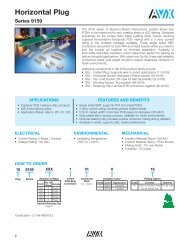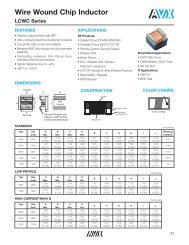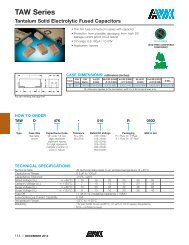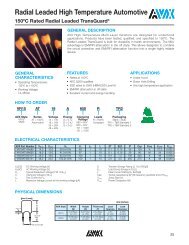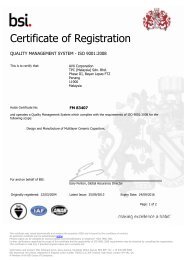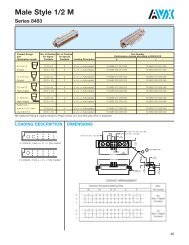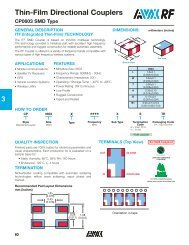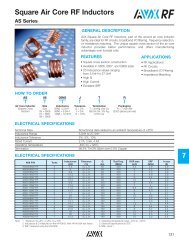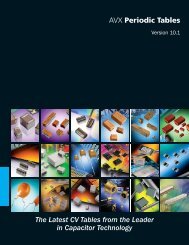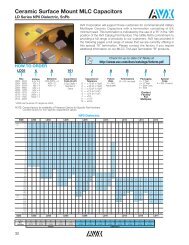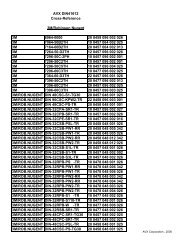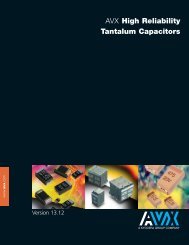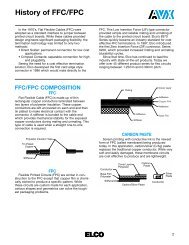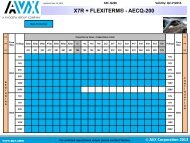BestCap Ultra Low ESR Supercapacitor - AVX
BestCap Ultra Low ESR Supercapacitor - AVX
BestCap Ultra Low ESR Supercapacitor - AVX
Create successful ePaper yourself
Turn your PDF publications into a flip-book with our unique Google optimized e-Paper software.
<strong>BestCap</strong> ®<br />
<strong>Ultra</strong>-low <strong>ESR</strong><br />
High Power Pulse <strong>Supercapacitor</strong>s<br />
INTRODUCING<br />
BESTCAP ® : A NEW GENERATION OF PULSE SUPERCAPACITORS<br />
<strong>Supercapacitor</strong>s (also referred to as Electrochemical<br />
Capacitors or Double Layer Capacitors) have rapidly become<br />
recognized, not only as an excellent compromise between<br />
“electronic” or “dielectric” capacitors such as ceramic,<br />
tantalum, film and aluminum electrolytic, and batteries (Figure<br />
1), but also as a valuable technology for providing a unique<br />
combination of characteristics, particularly very high energy,<br />
power and capacitance densities.<br />
There are, however, two limitations associated with<br />
conventional supercapacitors, namely: high <strong>ESR</strong> in the tens<br />
of Ohms range, and high capacitance loss when required to<br />
supply very short duration current pulses. <strong>BestCap</strong> ®<br />
successfully addresses both of these limitations.<br />
The capacitance loss in the millisecond region is caused by<br />
the charge transfer (i.e. establishment of capacitance) being<br />
carried out primarily by relatively slow moving ions in double<br />
layer capacitors.<br />
Figure 1. Specific Energy of Capacitor Types<br />
SPECIFIC ENERGY<br />
10000<br />
TANTALUM<br />
POLYMER<br />
ELECTROLYTIC<br />
ALUMINUM<br />
ELECTROLYTIC<br />
CAPACITOR<br />
1<br />
0.1 1<br />
10<br />
100 1000 10000<br />
Capacitance (mF)<br />
®<br />
1000<br />
100<br />
10<br />
Specific Energy (mFV/cc)<br />
In the above-mentioned “electronic” capacitors, the charge<br />
transfer is performed by fast electrons, thereby creating<br />
virtually instant rated capacitance value. In the <strong>BestCap</strong> ® , a<br />
unique proton polymer membrane is used – charge transfer<br />
by protons is close to the transfer rate for electrons and<br />
orders of magnitude greater than organic molecules. Figure<br />
2 below illustrates the severe capacitance loss experienced<br />
by several varieties of supercapacitors, under short pulse<br />
width conditions. It can also be seen from Figure 2, how well<br />
<strong>BestCap</strong> ® retains its capacitance with reducing pulse widths.<br />
For comparison purposes, the characteristic of an equivalent<br />
capacitance value aluminum electrolytic capacitor is shown<br />
in Figure 2. The electrolytic capacitor is many times the volume<br />
of the <strong>BestCap</strong> ® .<br />
Figure 2. Actual Capacitance vs. Pulse Width<br />
Actual Cap. (% of Nominal)<br />
100%<br />
80%<br />
60%<br />
40%<br />
20%<br />
0%<br />
1000 100<br />
Pulse Width (msec)<br />
10 1<br />
®<br />
EDLC-Electrochemical<br />
double layer capacitor<br />
Aluminum Electrolytic Capacitor<br />
manufacturer A EDLC<br />
manufacturer B EDLC<br />
manufacturer C EDLC<br />
2



